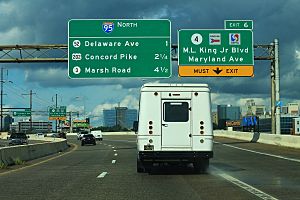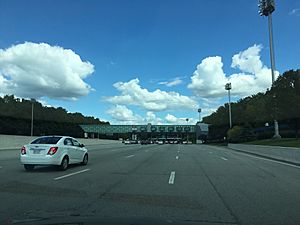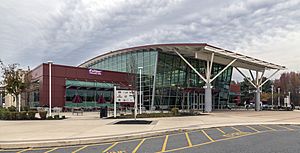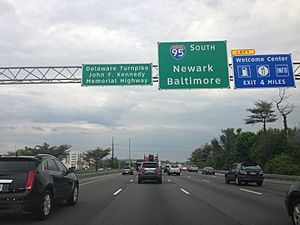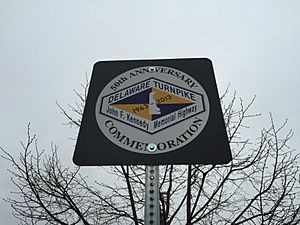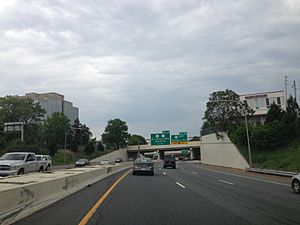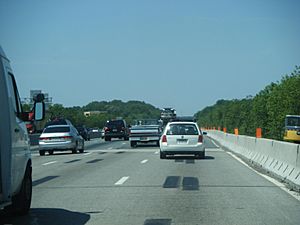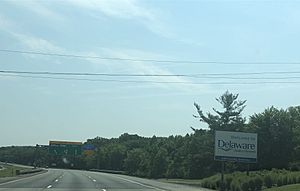Interstate 95 in Delaware facts for kids
Quick facts for kids
Interstate 95 |
|||||||
|---|---|---|---|---|---|---|---|
|
I-95 highlighted in red
|
|||||||
| Route information | |||||||
| Maintained by DelDOT | |||||||
| Length | 23.43 mi (37.71 km) | ||||||
| Existed | 1956–present | ||||||
| History | First section opened in 1963, completed in 1968 | ||||||
| Major junctions | |||||||
| South end | |||||||
| North end | |||||||
| Location | |||||||
| Counties: | New Castle | ||||||
| Highway system | |||||||
| Main route of the Interstate Highway System Main • Auxiliary • Business
|
|||||||
Interstate 95 (I-95) is a very important highway that runs along the East Coast of the United States. It stretches all the way from Miami, Florida in the south to the Canadian border in Houlton, Maine. In Delaware, I-95 covers about 23.43 miles (37.71 km). It goes through the Wilmington area in northern New Castle County. The highway starts near Newark at the Maryland state line and heads northeast to the Pennsylvania state line in Claymont.
I-95 is the only main Interstate highway that enters Delaware. However, it also has two smaller helper routes in the state: I-295 and I-495. The part of I-95 between the Maryland border and Newport is called the Delaware Turnpike or John F. Kennedy Memorial Highway. This section is a toll road, meaning you have to pay to use it. There is a toll booth near the state line.
Near Newport, I-95 connects with DE 141 and the start of I-295 and I-495. I-495 helps drivers go around Wilmington. I-95 then goes north through Wilmington, sharing the road with U.S. Route 202 (US 202). This part is known as the Wilmington Expressway. After Wilmington, I-95 continues northeast to Claymont. Here, I-495 joins back with I-95 just before the Pennsylvania state line.
Plans for a major road like I-95 through Wilmington started even before the Interstate Highway System was created. After the Delaware Memorial Bridge was built in 1951, people suggested building the Delaware Turnpike. This would help reduce traffic on US 40. When the Interstate Highway System was created in 1956, both these roads became part of I-95. Construction on the Delaware Turnpike began in 1957 and finished in 1963. Building I-95 through Wilmington started in the early 1960s. The section from Newport to downtown Wilmington opened in 1966. The part extending to the Pennsylvania border opened in 1968.
For a short time, between 1978 and 1980, I-95 was temporarily moved to the I-495 bypass route. This happened while a large bridge in Wilmington was being rebuilt. During this time, the route through Wilmington was called I-895. Since then, many improvements have been made to I-95, including widening parts of the road and rebuilding interchanges.
Contents
Exploring the Route of I-95 in Delaware
The Delaware Turnpike: A Journey from Maryland
|
|
|
|---|---|
| Location: | Newark–Newport |
| Length: | 13.34 mi (21.47 km) |
| Existed: | 1963–present |
I-95 enters Delaware from Maryland near Newark. From the state line, it becomes the Delaware Turnpike, also known as the John F. Kennedy Memorial Highway. This part of the highway has six lanes and goes through wooded areas. Soon after crossing into Delaware, drivers reach a toll plaza. Here, I-95 widens to eight lanes. It then meets DE 896, which leads to Newark and the University of Delaware.
After this, I-95 crosses the Christina River. It passes between industrial areas and farm fields. The road then goes over railroad tracks and DE 72. As it continues, the highway goes through more woods and suburban areas. The middle section of the highway widens for the Biden Welcome Center. This is a service area that drivers can access from both directions. A little further, I-95 reaches the DE 273 interchange near Christiana.
The highway then meets DE 1 and DE 7 near the Christiana Mall. This interchange has special ramps that help traffic flow smoothly. After this, I-95 widens to ten lanes. It passes under DE 58. The highway continues through woods and then crosses the Christina River again in Churchman's Marsh.
After this bridge, the lanes of I-95 spread out. A ramp for I-295 and DE 141 splits off. I-95 then crosses US 202 and DE 141. At this point, US 202 starts to share the road with I-95. Soon after, I-295 splits off to the southeast. This is where the Delaware Turnpike section ends. After I-295, I-95/US 202 turns north. It then reaches an exit for I-495, which is a bypass around Wilmington.
The Wilmington Expressway: Through the City
After the I-495 interchange, I-95/US 202 becomes the six-lane Wilmington Expressway. It goes northeast through marshland, crossing the Christina River again. The highway passes near the Russell W. Peterson Urban Wildlife Refuge. It also runs close to the Amtrak train line. The road then enters Wilmington and turns north. It passes by Daniel S. Frawley Stadium, where the Wilmington Blue Rocks baseball team plays. It also goes by the Chase Center on the Riverfront.
I-95/US 202 heads towards downtown Wilmington. It goes onto a large bridge called a viaduct. This bridge passes over railroad tracks. It then reaches an interchange that provides access to downtown and the Wilmington Riverfront. This access is through DE 4 and DE 48. The highway continues northeast through residential areas. It passes over DE 9. Further northeast, the highway goes below street level. It then reaches an interchange with DE 52.
After this, the road heads north and crosses Brandywine Creek. It goes through Brandywine Park. The highway then curves northeast again. It passes under another railroad line. Finally, it reaches an interchange with the northern end of DE 202. Here, US 202 splits off from I-95.
Beyond Wilmington: To the Pennsylvania Border
After US 202, I-95 leaves Wilmington. It enters the suburban area called Brandywine Hundred. It continues northeast as a four-lane road. The highway passes near the Rock Manor Golf Club and along a railroad line. It then crosses Matson Run and curves east. It goes over the railroad tracks and through wooded areas. The road crosses Shellpot Creek and reaches an interchange with DE 3 near Bellefonte.
After this exit, I-95 continues northeast through woods and residential areas. It passes near Bellevue State Park. The highway crosses Stoney Creek and Perkins Run. It then reaches an exit for Harvey Road near the villages of Arden, Ardentown, and Ardencroft. After this, the highway curves east and winds northeast through suburban neighborhoods in Claymont. In Claymont, I-95 connects with DE 92. Here, I-495 also merges back onto I-95. Following this, I-95 passes the Tri-State Mall before crossing into Pennsylvania.
I-95 in Delaware is a very busy road. It sees a lot of traffic every day. The entire length of I-95 in Delaware is part of the National Highway System. This is a network of roads that are important for the country's economy and transportation.
Paying to Drive: Tolls on I-95
I-95 has a main toll plaza on the Delaware Turnpike. It is located near the Maryland state line in Newark. For regular cars, the toll is $4.00, whether you are going north or south. You can pay with cash or with an E-ZPass.
When the highway first opened in 1963, the toll was only 30 cents. Before 1976, there were also tolls on the ramps at the DE 896, DE 273, and DE 7 interchanges. These ramp tolls needed exact change. Many drivers tried to avoid paying because they didn't have the right change. In 1970, they tried an "honor system" for a month, where drivers without exact change could mail in their tolls later. But most people didn't mail them, so this system stopped.
In 1976, a bill was signed to remove the three ramp tolls. Only the main toll plaza near the Maryland border remained. In 1981, there were plans to close the main toll plaza too. However, Governor Pierre S. du Pont IV started a project called "Operation Overhaul." This project used the money from the tolls to fund improvements to the turnpike and other roads in Delaware. In 2011, the toll plaza was rebuilt. It added special lanes for E-ZPass users, allowing them to drive through without stopping.
Helpful Stops: Services Along I-95
The Biden Welcome Center is a large service plaza located in the middle of I-95. It is between the DE 896 and DE 273 interchanges, east of Newark. This welcome center offers many things for travelers. It has a Sunoco gas station, electric vehicle charging stations, and a convenience store. You can also find several fast food restaurants there. There is a Delaware Visitor Center that provides tourist information. You can also buy Delaware-related items at a store called Postcards from Delaware. There is even a Tesla Supercharger station for electric cars. The Biden Welcome Center is managed by a company called HMSHost.
When the Delaware Turnpike first opened in 1963, it had a Hot Shoppes restaurant and an Esso gas station. In 1983, the restaurants were updated to Roy Rogers and Bob's Big Boy. This offered both sit-down and fast-food options. In 2009, the welcome center closed for a big renovation. A new building, new gas pumps, and better truck parking were added. The renovated service plaza reopened in June 2010.
On September 17, 2018, the service plaza was renamed the Biden Welcome Center. This was done to honor the Biden family, a well-known political family from Delaware. Joe Biden, who later became the 46th President, was a longtime U.S. Senator and 47th Vice President. Governor John Carney and members of the Biden family attended the renaming ceremony.
Building the Road: A Look at I-95's History
Planning and Construction of I-95
In 1948, a study in Wilmington suggested two new roads. These roads would run between southern Wilmington and the Pennsylvania border. They aimed to improve traffic flow. One road, Route A, followed the path of today's I-95. The other, Route B, went around the city to the east, like today's I-495.
After the Delaware Memorial Bridge opened in 1951, traffic on US 13 and US 40 became very heavy. So, in 1954, people suggested building a new limited-access road to the bridge. This road would help ease the congestion on US 40. In 1956, the Interstate Highway System was created. Two routes were proposed along the path of I-95. The state of Delaware decided to build the first part as a toll road, called the Delaware Turnpike. This allowed them to build it faster using state funds.
Construction on the Delaware Turnpike began in 1957. Work also started on bridges and interchanges. In Wilmington, the plan was to build I-95 through the central part of the city. Many local residents did not like this idea. They suggested other routes, but the city council approved the original plan in 1957. Demolition of homes began in January 1959 to make way for the highway.
By 1961, most of the Delaware Turnpike was finished. In 1962, bridges for I-95 over the Christina River and other areas were completed. The new lanes for DE 41/DE 141 through the I-95 interchange opened in 1962 and 1964.
The Delaware Turnpike officially opened on November 15, 1963. President John F. Kennedy and the governors of Delaware and Maryland attended the dedication ceremony. The opening of the turnpike allowed drivers to travel from Washington, D.C. to Boston without stopping at a traffic light. Building the Delaware Turnpike cost $30 million. After it opened, traffic on US 40 and US 301 dropped a lot. Sadly, eight days after dedicating the road, President Kennedy was assassinated. In December 1963, both the Delaware Turnpike and a connecting road in Maryland were renamed the John F. Kennedy Memorial Highway in his honor.
The rest of I-95, from the Christina River interchange to the Pennsylvania border, was built as a free highway. Construction continued through the mid-1960s. Building I-95 through Wilmington meant that many homes in the West Side neighborhood had to be moved or rebuilt. This construction also changed the local businesses and homes in Wilmington. In 1966, I-95 opened between the Christina River interchange and downtown Wilmington. This created a continuous highway connection between Wilmington and Baltimore. By November 1, 1968, the entire length of I-95 in Delaware was completed. Delaware was the third state to finish its section of I-95.
Ongoing Improvements to I-95
In November 1968, work began to widen the Delaware Turnpike from four to six lanes. This was needed because of increasing traffic. The widening was finished in December 1969. In the 1980s, the Delaware Turnpike was widened again, this time to eight lanes. From 1971 to 1978, there were studies for extending the turnpike south to Dover. This idea eventually became DE 1, which was built between 1987 and 2003.
In 1978, I-95 was temporarily rerouted along the I-495 bypass. This was because a major bridge, the South Wilmington Viaduct, needed to be rebuilt. The section of I-95 through Wilmington was called I-895 during this time. In 1980, I-95 and I-495 went back to their original routes, and I-895 was removed. In 1984, US 202 started sharing the road with I-95 through Wilmington.
In 2000, I-95 was completely rebuilt between US 202 and the Pennsylvania border. The old concrete pavement was replaced with asphalt. Drainage and bridges were also improved. During this work, traffic was sent onto I-495.
In 2003, construction began on a new bridge for DE 58 over I-95. This new bridge was built to allow for future widening of I-95. In 2007, I-95 was widened from eight to ten lanes between the DE 1/DE 7 and DE 141 interchanges. This was due to more traffic and development. This widening project was finished in November 2008.
To help with traffic at the DE 1/DE 7 interchange in Christiana, DelDOT made improvements. They added special ramps to make merging easier and reduce traffic jams. These new ramps opened in 2013.
In 2011, a project started to improve the interchange between I-95 and US 202/DE 202. This project aimed to reduce congestion. Ramps were widened, extended, or relocated. The project was completed in July 2015. It cost over $33 million, with most of the funding coming from the federal government.
In 2014, the I-495 bridge over the Christina River had to close because of structural problems. During this closure, traffic from I-495 was sent onto I-95, causing more congestion in Wilmington. The I-495 bridge reopened later that year.
In 2016, a project began to improve the interchange with DE 141. This project will rebuild bridges and add safety improvements. There are also plans to rebuild the interchange with DE 896. This project, costing $143 million, is planned to start in 2022. It will add new ramps to improve safety and traffic flow.
What's Next for I-95 in Delaware?
DelDOT plans to completely rebuild a section of I-95 in Wilmington. This project will cover the area from the southern end of I-495 to the Brandywine Creek bridge. It is expected to cost $200 million. Several bridges will be repaired, and new guardrails will be installed. Some entrance ramps will also be rebuilt. During construction, parts of the highway will be reduced to two lanes.
I-95 Exit List in Delaware
The entire route is in New Castle County.
| Location | Mile | Roads intersected | Notes | ||
|---|---|---|---|---|---|
| Newark | 0.00 | 0.00 | – | This is where I-95 continues into Maryland; it's the start of the Delaware Turnpike. | |
| 0.54 | 0.87 | Newark Toll Plaza | |||
| 2.34 | 3.77 | 1 | Signed as exits 1A (south) and 1B (north) southbound; this is the last exit before the toll if you're going south; it also leads to the University of Delaware. | ||
| 5.10 | 8.21 | Biden Welcome Center | |||
| Christiana | 6.63 | 10.67 | 3 | Signed as exits 3A (east) and 3B (west) northbound. | |
| 7.89 | 12.70 | 4A | This is Exit 165 on DE 1 / DE 7; it gives access to Christiana Hospital and Delaware Park. | ||
| 8.13 | 13.08 | 4B | |||
| Newport | 10.56 | 16.99 | 5A | This is where US 202 starts to run with I-95; signed as exit 5 northbound; it's exit 3B on DE 141; US 13 is signed southbound. | |
| 11.50 | 18.51 | 5B | This ramp is shared with exit 5A southbound; it's exit 3A on DE 141. | ||
| 11.75– 13.34 |
18.91– 21.47 |
5C | This is the start of I-295; signed for New Jersey / New York northbound, and New Castle southbound. | ||
| 12.65 | 20.36 | 5D | This is a northbound exit and southbound entrance; it's the start of I-495. | ||
| 13.34 | 21.47 | This is the northern end of the Delaware Turnpike. | |||
| Wilmington | 14.78 | 23.79 | 6 | There is no southbound exit here; it gives access to Wilmington station and the Wilmington Riverfront. | |
| 15.45 | 24.86 | This is a southbound exit and entrance; it also gives access to Wilmington station. | |||
| 15.68 | 25.23 | 7 | Signed as exits 7A (south) and 7B (north) southbound; it gives access to Downtown Wilmington and Brandywine Valley Attractions. | ||
| 16.97 | 27.31 | 8 | This is where US 202 stops running with I-95; it also serves DE 202; it gives access to Wilmington and Alfred I. duPont hospitals and Brandywine Valley Attractions. | ||
| Bellefonte | 19.12 | 30.77 | 9 | This exit gives access to Bellevue State Park. | |
| Claymont | 21.30 | 34.28 | 10 | Harvey Road | This is a northbound exit and southbound entrance. |
| 23.10 | 37.18 | 11 | If you're going southbound, this exit is via I-495 exit 6. | ||
| 23.43 | 37.71 | This is the northern end of I-495; it's a southbound exit and northbound entrance; the southbound exit ramp actually starts in Pennsylvania. | |||
| – | This is where I-95 continues into Pennsylvania. | ||||
| 1.000 mi = 1.609 km; 1.000 km = 0.621 mi | |||||
Other Important Routes: Auxiliary Highways
I-95 has two special helper routes in Delaware. These are called auxiliary routes.
- I-295 starts from I-95 near Newport. It goes east to the Delaware Memorial Bridge. Here, it crosses the Delaware River into New Jersey. In New Jersey, I-295 connects with the New Jersey Turnpike. It then continues northeast, acting as a bypass around Philadelphia. I-295 goes north of Trenton, New Jersey and enters Pennsylvania. It ends when it meets I-95 in Bristol Township.
- I-495 is a bypass route that goes around Wilmington to the east. I-495 heads north from I-95 south of Wilmington, near Newport. It passes by the Port of Wilmington and runs along the Delaware River. Finally, it merges back with I-95 at the Pennsylvania state line in Claymont.
Images for kids




